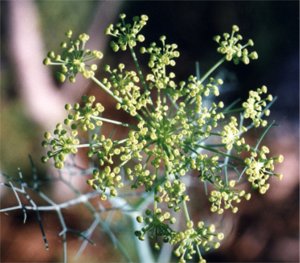Fennel
by Valerie (August 12, 2000)
 Although we have a number of herbs, I am not a very discriminating cook, so most of them are just in our gardens because they happen to grow well in this climate, look nice, smell nice, or are host plants for various insects. Fennel (Foeniculum vulgare) fits all these requirements. A tall perennial, fennel not only grows for several years before either freezing out or drying up to the point of no return, but also reseeds very easily.
Although we have a number of herbs, I am not a very discriminating cook, so most of them are just in our gardens because they happen to grow well in this climate, look nice, smell nice, or are host plants for various insects. Fennel (Foeniculum vulgare) fits all these requirements. A tall perennial, fennel not only grows for several years before either freezing out or drying up to the point of no return, but also reseeds very easily.
Fennel is a handsome plant, with its smooth green stems and feathery leaves. The flowers are yellow and resemble those of Queen Anne's lace, but are not as full. The photo at left shows the buds just before they open. In very early spring, the fennel grows quickly, producing abundant foliage and adding a pleasant texture to the gardens. At this time of year, the smell of the plants is also most noticeable. They have the aroma of licorice. A bronze variety of fennel is also available, but I tried it once and it was much more delicate than the green type, and didn't make it through the first winter. By late spring, the black swallowtail caterpillars have begun to hatch out and are in the process of defoliating all the branches. All summer, the fennel continues to recover from periodic onslaughts of caterpillar munching, interspersed with times when the wasps have devoured all the grazers. By fall, all that is usually left are branches with a few dried up wisps of leaf hanging from the stems. Any seeds that manage to make it past the caterpillars are dry and still attached to the tops of the plants. These will germinate readily if pressed into the ground.
|

